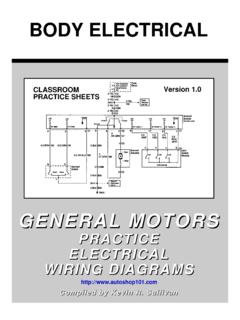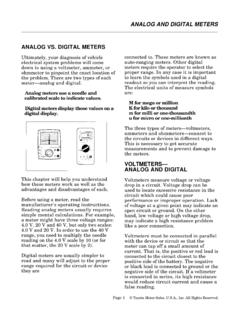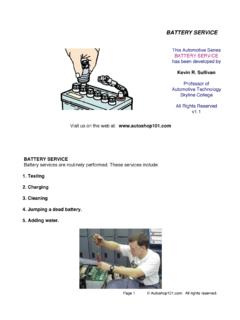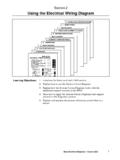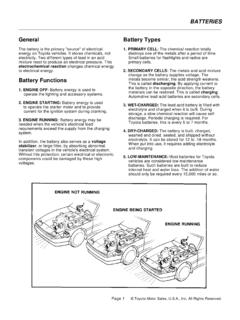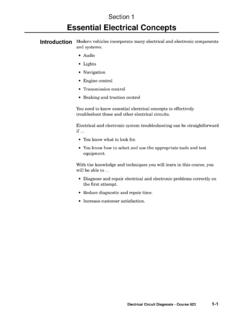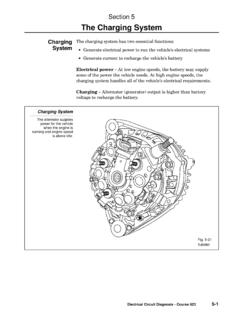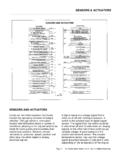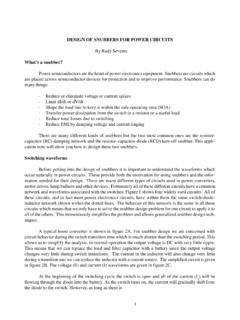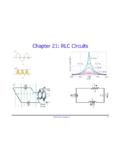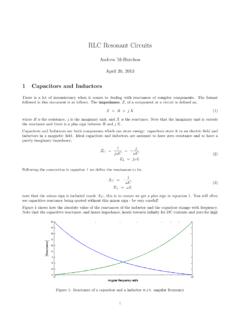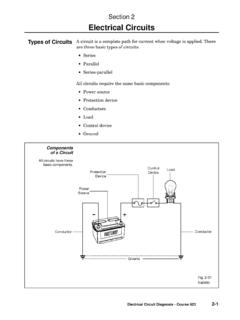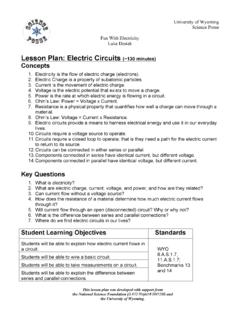Transcription of ELECTRICAL CIRCUITS Electrical Circuits - Autoshop …
1 ELECTRICAL CircuitsA complete path, or circuit , is needed before voltage can cause a current flow through resistances to perform are several types of CIRCUITS , but all require the same basic components. A power source (battery or alternator) produces voltage, or ELECTRICAL potential. Conductors (wires, printed circuit boards) provide a path for current flow. Working devices, or loads (lamps, motors), change the ELECTRICAL energy into another form of energy to perform work. Control devices (switches, relays) turn the current flow on and off. And, protection devices (fuses, circuit breakers) interrupt the current path if too much current flows. Too much current is called an overload, which could damage conductors and working list of five things to look for in any circuit :1. Source of Voltage2. Protection Device3. Load4. Control5. GroundWe will be identifying these items when we look at Automotive CIRCUITS a little later in this CIRCUITS Page 1 Toyota Motor Sales, , Inc.
2 All Rights Reserved. Types Of CircuitsThere are three basic types of CIRCUITS : series, parallel, and series-parallel. The type of circuit is determined by how the power source, conductors, loads, and control or protective devices are CIRCUITA series circuit is the simplest circuit . The conductors, control and protection devices, loads, and power source are connected with only one path for current. The resistance of each device can be different. The same amount of current will flow through each. The voltage across each will be different. If the path is broken, no current CIRCUITA parallel circuit has more than one path for current flow. The same voltage is applied across each branch. If the load resistance in each branch is the same, the current in each branch will be the same. If the load resistance in each branch is different, the current in each branch will be different.
3 If one branch is broken, current will continue flowing to the other CIRCUITA series-parallel circuit has some components in series and others in parallel. The power source and control or protection devices are usually in series; the loads are usually in parallel. The same current flows in the series portion, different currents in the parallel portion. The same voltage is applied to parallel devices, different voltages to series devices. If the series portion is broken, current stops flowing in the entire circuit . If a parallel branch is broken, current continues flowing in the series portion and the remaining CIRCUITS Page 2 Toyota Motor Sales, , Inc. All Rights Reserved. SERIES CIRCUITSIn a series circuit , current has only one path.
4 All the circuit components are connected so that the same amount of current flows through each. The circuit must have continuity. If a wire is disconnected or broken, current stops flowing. If one load is open, none of the loads will of Ohm's LawApplying Ohm's Law to series CIRCUITS is easy. Simply add up the load resistances and divide the total resistance into the available voltage to find the current. The voltage drops across the load resistances are then found by multiplying the current by each load resistance. For calculation examples, see page 6 in the Ohms law drop is the difference in voltage (pressure) on one side of a load compared to the voltage on the other side of the load. The drop or loss in voltage is proportional to the amount of resistance. The higher the resistance, the higher the voltage troubleshooting, then, you can see that more resistance will reduce current and less resistance will increase current.
5 Low voltage would also reduce current and high voltage would increase current. Reduced current will affect component operation (dim lamps, slow motors). But, increased current will also affect component operation (early failure, blown fuses). And, of course, no current at all would mean that the entire circuit would not operate. There are ELECTRICAL faults that can cause such problems and knowing the relationship between voltage, current, and resistance will help to identify the cause of the CIRCUITS Page 3 Toyota Motor Sales, , Inc. All Rights Reserved. PARALLEL CIRCUITSIn a parallel circuit , current can flow through more than one path from and to the power source. The circuit loads are connected in parallel legs, or branches, across a power source.
6 The points where the current paths split and rejoin are called junctions. The separate current paths are called branch CIRCUITS or shunt CIRCUITS . Each branch operates independent of the others. If one load opens, the others continue of Ohm's LawApplying Ohm's Law to parallel CIRCUITS is a bit more difficult than with series CIRCUITS . The reason is that the branch resistances must be combined to find an equivalent resistance. Just remember that the total resistance in a parallel circuit is less than the smallest load resistance. This makes sense because current can flow through more than one path. Also, remember that the voltage drop across each branch will be the same because the source voltage is applied to each branch. For examples of how to calculate parallel resistance, see page troubleshooting a parallel circuit , the loss of one or more legs will reduce current because the number of paths is reduced.
7 The addition of one or more legs will increase current because the number of paths is increased. Current can also be reduced by low source voltage or by resistance in the path before the branches. And, current can be increased by high source voltage or by one or more legs being bypassed. High resistance in one leg would affect component operation only in that CIRCUITS Page 4 Toyota Motor Sales, , Inc. All Rights Reserved. SERIES-PARALLEL CIRCUITSIn a series-parallel circuit , current flows through the series portion of the circuit and then splits to flow through the parallel branches of the circuit . Some components are wired in series, others in parallel. Most automotive CIRCUITS are series-parallel, and the same relationship between voltage, current, and resistance of Ohm's LawApplying Ohm's Law to series-parallel CIRCUITS is a matter of simply combining the rules seen for series CIRCUITS and parallel CIRCUITS .
8 First, calculate the equivalent resistance of the parallel loads and add it to the resistances of the loads in series. The total resistance is then divided into the source voltage to find current. Voltage drop across series loads is current times resistance. Current in branches is voltage divided by resistance. For calculation examples, see page troubleshooting a series-parallel circuit , problems in the series portion can shut down the entire circuit while a problem in one leg of the parallel portion may or may not affect the entire circuit , depending on the problem. Very high resistance in one leg would reduce total circuit current, but increase current in other legs. Very low resistance in one leg would increase total circuit current and possibly have the effect of bypassing other CIRCUITS Page 5 Toyota Motor Sales, , Inc.
9 All Rights Reserved. Ohm's LawFast, accurate ELECTRICAL troubleshooting is easy when you know how voltage, current, and resistance are related. Ohm's Law explains the relationship: Current (amps) equals voltage (volts) divided by resistance (ohms) .. I = E R. Voltage (volts) equals current (amps) times resistance (ohms) .. E = I X R. Resistance (ohms) equals voltage (volts) divided by current (amps) .. R E = OHM'S LAWThe effects of different voltages and different resistances on current flow can be seen in the sample CIRCUITS . Current found by dividing voltage by resistance. This can be very helpful when diagnosing ELECTRICAL problems: When the resistance stays the same .. current goes up as voltage goes up, and current goes down as voltage goes down. A discharged battery has low voltage which reduces current. Some devices may fail to operate (slow motor speed).
10 An unregulated alternator may produce too much voltage which increases current. Some devices may fail early (burned-out lamps). When the voltage stays the same .. current goes up as resistance goes down, and current goes down as resistance goes up. Bypassed devices reduce resistance, causing high current. Loose connections increase resistance, causing low CIRCUITS Page 6 Toyota Motor Sales, , Inc. All Rights Reserved. SAMPLE CALCULATIONSHere are some basic formulas you will find helpful in solving more complex ELECTRICAL problems. They provide the knowledge required for confidence and thorough understanding of basic following abbreviations are used in the formulas:E = VOLTSI = AMPSR = OHMSP = WATTS Ohm's LawScientifically stated, it says: "The intensity Of the current in amperes in any ELECTRICAL circuit is equal to the difference in potential in volts across the circuit divided by the resistance in ohms of the circuit .
